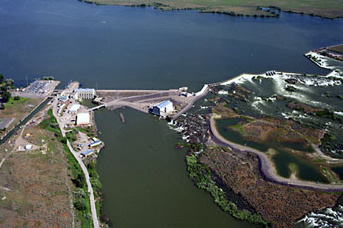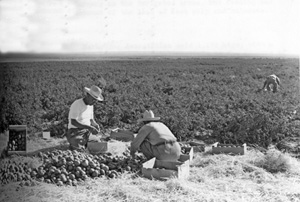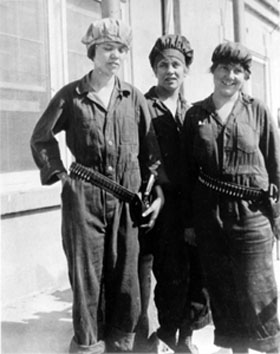
The origin of the word Minidoka is unknown, but some postulate it is an American Indian word that means “well or spring,” and others think it is Shoshone for “broad expanse,” a reference to Idaho’s broad Snake River Plain, which sweeps across southern Idaho like a giant smile. From the air, green irrigation circles near the little towns of Rupert, Heyburn and Burley break this brown expanse of sagebrush, which a century ago was home to only a few scattered ranches. That changed with the completion, in 1906, of Minidoka Dam, the initial component of the Bureau of Reclamation’s Minidoka Project. Over the next dozen years, as the desert bloomed, 2,208 farms were launched and six towns born, three of which, including Rupert and Heyburn, were laid out by the Bureau of Reclamation.
Today, the multi-faceted Minidoka Project, which provides irrigation water to more than one million acres, counts a total of seven dams and thousands of miles of canals, laterals and drains. Still at the core is the more than 100-year-old Minidoka Dam, significant as the Bureau of Reclamation’s first embankment dam and the first Federally-built dam in the Pacific Northwest to include a powerplant to supply electricity. Minidoka Dam stands only 86 feet high, but its spillway, designed to handle the great flow of the Snake River, is made of concrete and stretches 2,300 feet long, or nearly one-half of a mile.
The Snake River, which rises in the mountains of Yellowstone National Park, is the largest tributary of the Columbia River. It flows southwest, crosses Idaho and then turns north to form the eastern boundary of Oregon before emptying into the Columbia River near Pasco, Washington. The Snake’s broad plain through Idaho has long been an important transportation route. In the 19th century, thousands of overlanders came this way on the Oregon Trail, its ruts still visible along Interstate 84/86 west of American Falls. A far less glorious chapter in the region’s history occurred during World War II when Minidoka Project lands at Hunt, in remote Jerome County, Idaho, were selected as the site for a Japanese American internment camp. In operation from August 1942 to October 1945, Minidoka Relocation Center, 15 miles north of Twin Falls, housed a maximum population of 7,318 Japanese Americans.
Studies associated with the potential to build a dam at the Minidoka Rapids site started as early as the 1880s. The site was quickly adopted by the fledging U.S. Reclamation Service as the location for the first Reclamation project in Idaho. On April 23, 1904, Secretary of the Interior Ethan A. Hitchcock approved the Minidoka Project. By mid-summer, the design for the dam was completed, the first significant work by a young engineer, John Lucian Savage, who would later become Reclamation’s Chief Designing Engineer. By September, the construction contract was awarded and work soon started on excavation of a diversion channel and foundation trench for a massive eight-foot-high core wall needed to prevent leakage through the dam's embankment. The first concrete was placed on June 26, 1906, and that November the reservoir, called Lake Walcott, began to fill. It was named in honor of Charles D. Walcott, first director of the U.S. Reclamation Service (today’s Bureau of Reclamation). It is of interest to note that many of the laborers on the dam hailed from outside the United States and included Greeks, Italians, Austrians, Irish, and Spanish.

Topography within the project service area allowed only land near the river to be served directly by gravity flow alone. On the higher terraces, water must be pumped up to a terrace and then it can be delivered by gravity flow; these lands are respectively called the “gravity” and the “pump” divisions. Construction of project canals serving the gravity division began in 1905, but Idaho’s severe weather, where the mercury can drop to 20 degrees below zero, and incompetence on the part of some contractors seriously delayed the work. Many farmers in the gravity division did not receive water until 1908. Funding issues delayed start of construction of the powerplant and the southside pump division canals and pump lift stations until 1908. Again, sub-zero weather slowed construction. It wouldn’t be until May 1909, following installation of one generator unit in the powerplant and completion of one pumping plant, that irrigation water first reached a portion of the pump division, and it was not until 1911 that all lands received water. That same year Minidoka Powerplant became fully operational, one of the first three powerplants built by the Bureau of Reclamation. (Another was at Theodore Roosevelt Dam on Arizona’s Salt River and another on the Strawberry Valley Project in Utah.) Minidoka Powerplant was constructed to provide power for the pump division lift stations, but it proved to generate more power than needed for project purposes. Reclamation received authorization to sell the excess power to provide electricity to project area towns and farms; electricity was a rarity in rural America at that time. This rural power program was later used as an example to obtain support for passage of the Rural Electrification Act.
Other dams on the Minidoka Project soon followed Minidoka Dam. In 1907, the naturally fed Jackson Lake, in what is now Grand Teton National Park, was dammed to increase its volume. Idaho’s American Falls Dam followed in 1927, requiring the Bureau of Reclamation to relocate most of the town of American Falls, three-quarters of which was inundated by American Falls Reservoir. In the 1930s came Island Park Dam, north of Ashton, Idaho, and Grassy Lake Dam, northwest of Moran, Wyoming, as well as two diversion dams and more canals.
The Minidoka Project’s wide and meandering North Side Canal holds the inglorious distinction of serving as the southern boundary of the Minidoka Relocation Center, established after the Japanese bombing of Pearl Harbor in 1941. Wartime hysteria led President Franklin D. Roosevelt to sign Executive Order 9066, which forced more than 120,000 persons of Japanese ancestry, mostly on the West Coast, to leave their lives behind and move inland to one of ten relocation centers.

The first Japanese Americans arrived at Minidoka on August 10, 1942, and, like Idaho farmers in the Snake River Valley, depended on irrigation. To water their fields, internees dug a ditch from Reclamation’s Milner-Gooding Canal, which ran five miles to the east of the camp barracks. By 1944, they had cleared 740 acres, where they grew a variety of garden vegetables. They also raised hogs and chickens and built a landscaped park and picnic grounds, which they watered initially by hand-carrying water from Reclamation canals. The War Relocation Authority (WRA) ran the Minidoka camp, which was surrounded by five miles of barbed wire fencing and eight watch towers. Reclamation employees, however, supervised internees in maintaining the Milner-Gooding Canal, as well as Reclamation laterals and gauging stations.
After the relocation center was closed, the land where it stood was divided into small farms. In 1947 and 1949, the farms were allotted to World War II veterans whose names were drawn in a lottery. Minidoka Project lands near Paul, Idaho, also were the site of a World War II Prisoner of War camp, where 3,000 German and Italian soldiers arrived in May 1944, as well as Russians, who had been pressed into service by the Nazis on the Western Front.
Over the years, Minidoka Dam has undergone additions and repairs, including the current reconstruction of its spillway. A sixth generating unit was installed in the powerplant in 1927, and a seventh in 1942. Then, in the early 1990s, work began on a new powerplant, with Units 8 and 9 added in 1997. Reclamation retired the original five generators from service but preserved them as museum pieces in the original powerhouse building, where visitors still can see them.
Visit the National Park Service Travel Bureau of Reclamation's Historic Water Projects to learn more about dams and powerplants.
Last updated: January 13, 2017
